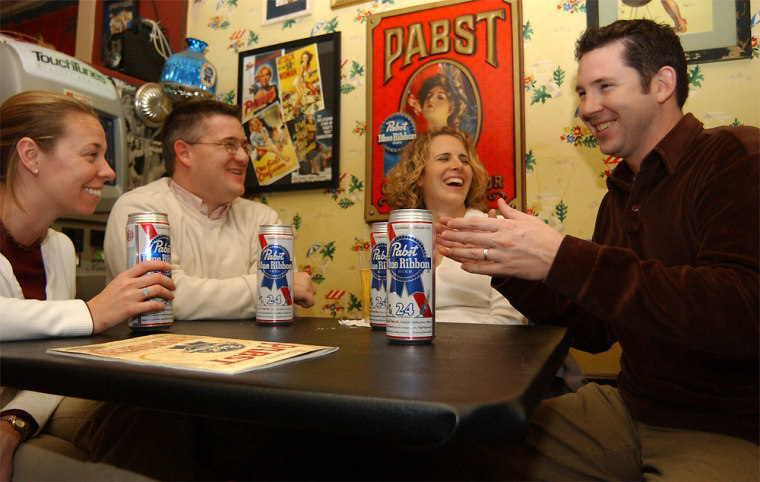Matt Dixon sips beer from a red, white and blue aluminum can in a smoky corner of Betty’s Food and Spirits, a dimly lit hangout for local artists, college students and restaurant workers.
Bartenders pour 13 different microbrews for $3.75 a pint at Betty’s, but the best-selling beer is Dixon’s choice, $1.50-a-pint Pabst Blue Ribbon, a former blue-collar favorite decades removed from its heyday.
Pabst Blue Ribbon, or simply PBR, is enjoying an unlikely comeback across the country. After a steady decline since the 1970s, sales rose about 5 percent in 2002 and 15 percent in 2003.
“It’s just cold and refreshing,” Dixon said between gulps. “It’s not a bad beer. You just have to get beyond the fact that it’s what your dad drinks.”
In 2001, sales of the 160-year-old brand had fallen to less than 1 million barrels, about one-tenth its peak in 1975, said Pabst Brewing Co. senior brand manager Neal Stewart.
Betty’s owner Elizabeth Lessner said distributors laughed at her when she began asking for kegs of Pabst three years ago. But it was about that time that Pabst’s comeback had started — Stewart said the beer’s resurgence began when young consumers in Portland, Ore., adopted the brew.
There had been no change in marketing. Pabst somehow appealed to trendsetters: punk rockers, people into bluegrass, kayakers and mountain bikers, Stewart said.
The brand is the top seller in Portland’s Lutz Tavern, which began carrying it in 1999 to replace a discontinued regional beer.
“It’s really popular with not only the college students but also the working class guy and the Social Security crowd,” said Lilias Barisich, whose family has operated the bar since 1954.
The revival spread to cities like San Francisco and Seattle before hopping across the country to the Northeast, Stewart said. By some accounts, its young buyers are rebelling against established, mass-marketed brands.
“There’s a theory that there’s a niche out here for a consumer that’s anti-marketing,” said Eric Shepard, executive editor of Beer Marketer’s Insights.
Betty’s owner Lessner said, “People are really sick of the Budweiser-type marketing with naked girls and cars. Pabst is kinda hokey and nostalgic and people like it.”
The San Antonio-based Pabst Brewing Co.’s marketing strategy — or lack thereof — eschews conventional advertising in favor of generating word-of-mouth buzz.
While you won’t find any Pabst commercials on NFL telecasts or FM radio, Stewart said you might notice the company sponsoring an art gallery opening or running ads for bands in local publications. But chances are, the only place you’ll see the Pabst logo is at a local bar or convenience store beer aisle: The company’s marketing budget is minuscule by industry standards.
In 2002, Pabst spent $427,000 on measured media, which includes television, magazines, billboards, radio and newspapers, compared to Anheuser-Busch’s $419 million and Miller’s $275 million.
The low-key approach has resonated with customers. At Betty’s, Tanya Brooks ordered a Pabst and explained she’s sick of beer advertising that exploits women. The 28-year-old waitress said she’d be disappointed to ever see a Pabst Blue Ribbon advertising campaign.
“My dad drank PBR. It was never about being sexy,” she said.
At the Cave, a bar known for live music across the street from the University of North Carolina in Chapel Hill, Pabst is one of the most popular and cheapest beers, owner Dave Sorrell said.
“It’s what I drink,” he said. “It’s just a plain, old, simple beer.”
Distributors across the country confirm the brand’s success but say they don’t quite understand it. In Nashville, Tenn., sales shot up 99 percent in 2003, said DET Distributing Co. general manager John Curley.
“It’s almost got this cult-type following,” he said. “I have never seen that kind of growth, especially in a brand that’s been down and out.”
On Chicago’s north side, Louis Glunz Beer Inc. added Pabst to a list of beers it recommends to bars and stores after sales went up by about 35 percent in each of the past two years, general manager Jerry Glunz said.
“Pabst was not that kind of beer you had to sell in only the cheap joints anymore,” he said.
Despite PBR’s success, its parent company is still a distant fourth in the domestic beer market, Shepard said. In 2003, the Pabst Brewing Co. sold an estimated 8 million barrels overall and 1 million barrels of PBR, while Anheuser-Busch sold about 103 million barrels, Miller 38 million and Coors 22 million.
“It’s a nice story for Pabst that Pabst Blue Ribbon has caught on and is quite popular in many markets, but I don’t know if any of the major brewers are quaking in their boots,” Shepard said.
